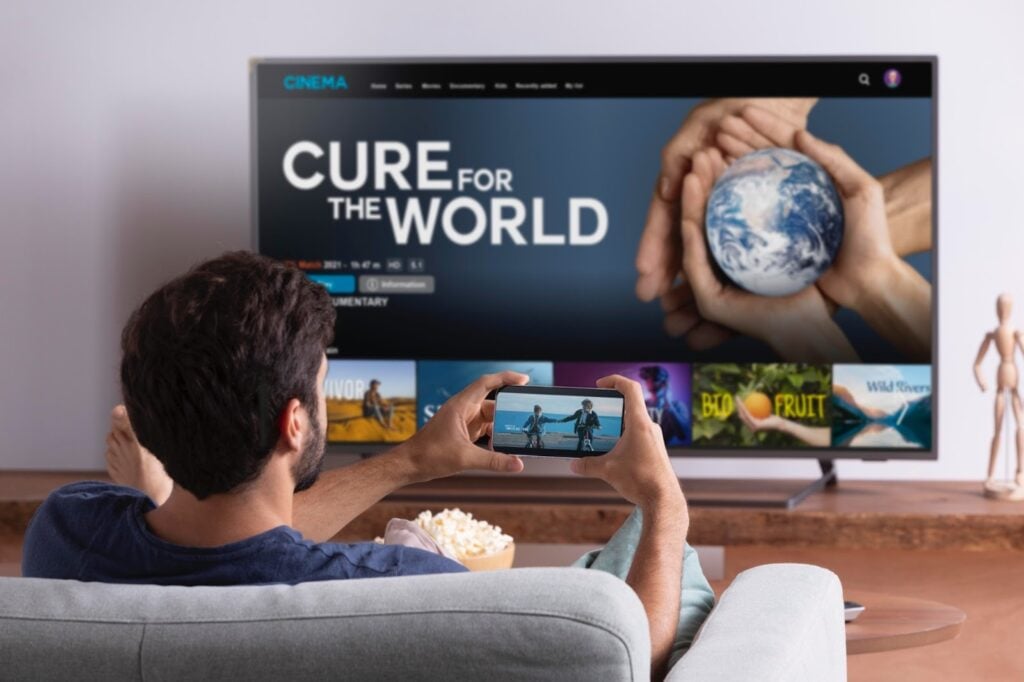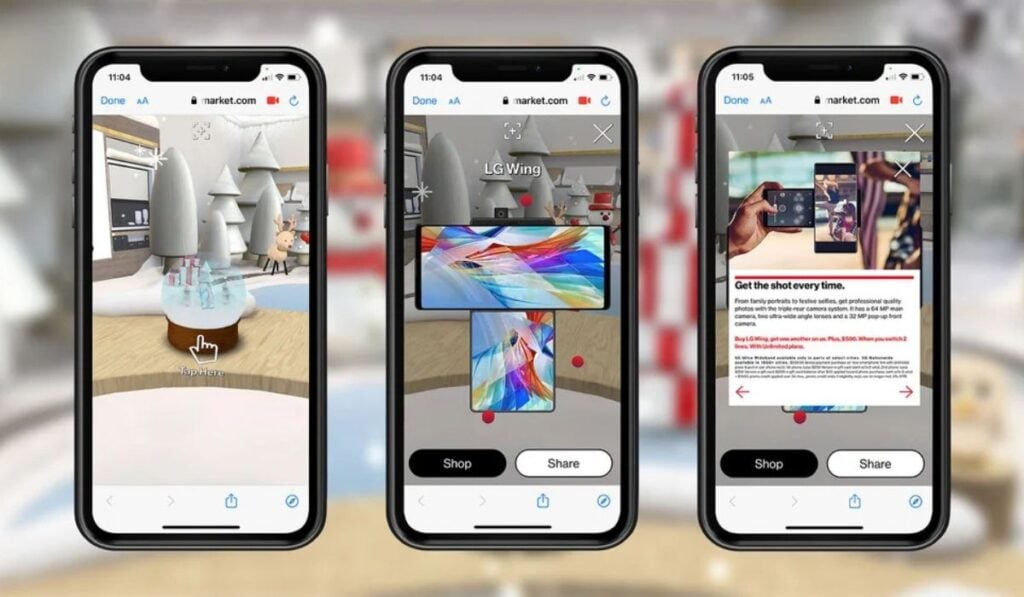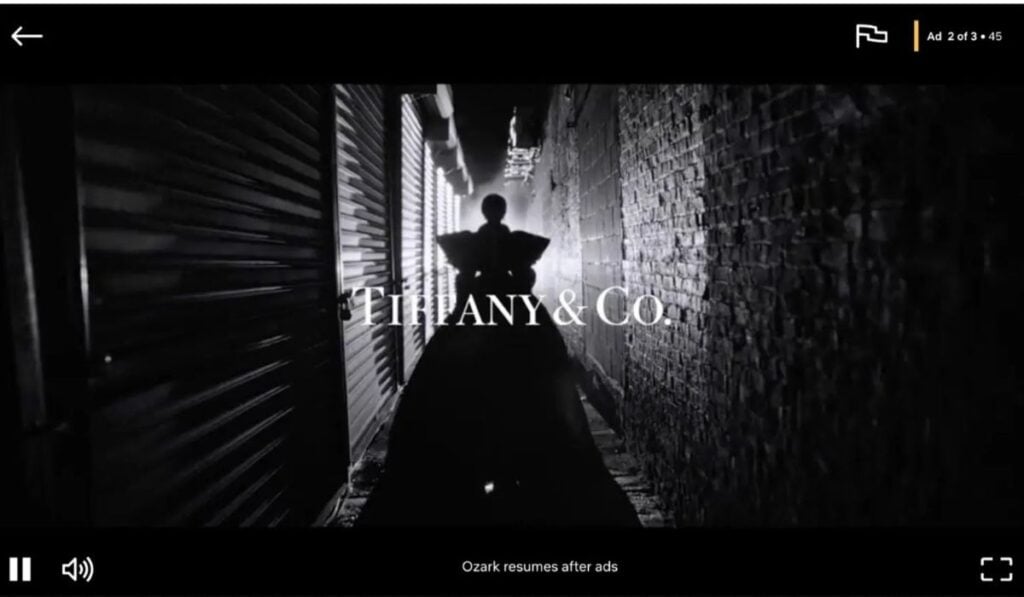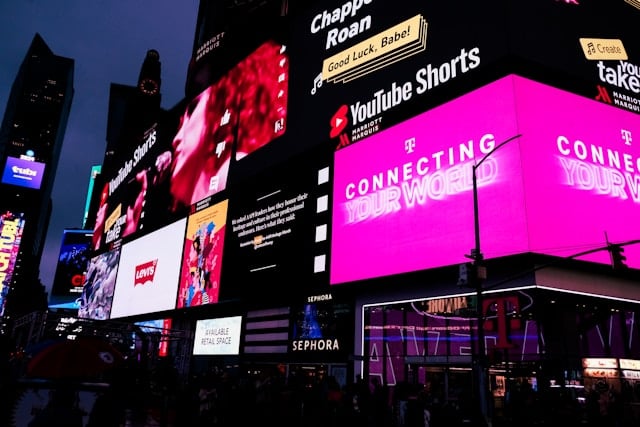The holiday season is where attention, emotion, and spending all spike at once, and connected TV advertising is quickly becoming the place where all three intersect. As cord-cutting accelerates and streaming dominates living rooms, CTV gives brands the chance to show up on the biggest screen in the house with the precision and measurability of digital.
For any modern holiday campaign strategy, relying only on crowded social feeds or saturated search isn’t enough. CTV lets marketers combine premium storytelling with smarter audience targeting and clear attribution at the exact moment people are most open to discovering new gifts, traditions, and brands.
And when you layer in personalized video gifting, like QR-linked holiday messages or video add-ons to physical gifts, CTV becomes more than just a reach channel; it becomes the emotional entry point into a richer, multi-touch experience.
In this blog, we’ll explore how marketers can use connected TV advertising to drive holiday impact: from redefining reach and frequency to smarter audience targeting, measurement, and creative strategies that turn big-screen impressions into real seasonal results.
The Rise of Connected TV Advertising: Why It Matters for Holiday Campaigns

Did you know that at least one internet-connected TV device, such as an Apple TV, Roku, Amazon Fire TV Stick, or game console, is owned by about 88% of US homes? Connected TV (CTV) refers to any television that is connected to the internet, enabling users to stream content via apps like Netflix, YouTube, and Hulu. As more households transition away from traditional cable TV, the number of connected TV users continues to increase, providing brands with a massive, engaged audience.
What is CTV Advertising?
Connected TV advertising refers to digital ads displayed on internet-connected televisions through streaming platforms. It allows advertisers to reach a targeted audience with the immersive, high-impact format of TV, while benefiting from the precision and measurement capabilities of digital media.
For example, HP partnered with The Trade Desk to use Unified ID 2.0 (UID2) for privacy-friendly targeting as third-party cookies phase out, reaching new audiences on CTV platforms like Disney and Hulu. This identity-based solution allowed HP to expand its reach by 8% while reducing costs, achieving a 23% lower cost per household and a cost of $0.16 per unique household. The success of UID2 in driving efficient CTV advertising highlights its effectiveness in reaching targeted audiences without relying on third-party cookies.
Another example is how SIG SAUER partnered with Vibe for its first nationwide CTV ad campaign, aiming to drive strong results for its binoculars line by targeting the right audience. With Vibe’s retargeting and tracking tools, SIG achieved a 1767% Return on Ad Spend (ROAS), a $25 CPM, and a 2% conversion rate, all while keeping the cost per view at just $0.03. This campaign demonstrated the power of targeted CTV ads in driving high engagement and attracting new customers.
CTV’s Growing Influence on Holiday Shopping
CTV is stepping into the void left by social media and search platforms, which are experiencing diminishing returns due to rising CPMs, algorithmic volatility, and audience fatigue. In fact, 34% of U.S. CTV viewers report that streaming TV ads help with holiday gift discovery, compared to 32% for traditional TV ads, according to LG Ad Solutions. This is a key opportunity for brands to take advantage of CTV’s ability to create impactful, emotional connections during the holiday season. CTV formats now outperform app home-screen placements, print, and audio for seasonal influence, a powerful indicator that sight-sound-motion ads are still unmatched in their ability to drive discovery.
CTV’s ability to deliver measurable outcomes and higher emotional lift is why marketers are increasingly shifting their focus to this format for holiday campaigns. As eMarketer notes, “CTV is where incremental reach now lives,” and its ability to deliver premium video content on a digital platform offers measurable results.
Real-World Holiday Examples Across Top CTV Channels
Here’s a quick cheat-sheet with one real holiday-ish example for each CTV environment and what each is best for.
1. Roku – Verizon “5G Holiday” interactive CTV ads
- Example: Verizon ran interactive 5G holiday campaigns on Roku, using Roku’s interactive CTV formats so viewers could learn about device deals, explore offers, and click through with their remote during holiday programming. These units let Verizon turn a standard holiday brand spot into an experience where people could actively engage with plan and device promos on the big screen.
- Best for: Promo-led, offer-focused holiday campaigns – ideal when you want to combine festive storytelling with clear, clickable deals on phones, plans, or electronics.

2. Hulu – Kroger “The Case of the Disappearing Food” with Shop the Scene
- Example: Kroger ran a holiday spot on Hulu called “The Case of the Disappearing Food”, tied to Hulu’s Shop the Scene tech so viewers could browse and buy featured grocery items directly from the content.
- Best for: Contextual, grocery/CPG holiday ads – perfect for recipe, entertaining, and “stock up for the holidays” messaging with shoppable overlays.

3. Amazon Streaming TV (Fire TV / Freevee via Amazon Ads)
- Example: Amazon Ads highlights a holiday promotion for electronics where a retailer used Streaming TV ads to showcase smart-home devices for the season, then closed the loop with Amazon DSP retargeting to convert engaged viewers.
- Best for: Retail + performance – ideal when you want CTV awareness plus strong lower-funnel impact, powered by Amazon’s shopping and intent data.
4. Samsung Ads (Samsung Smart TVs / Samsung TV Plus)
- Example: Samsung Ads showcases seasonal and deal-based campaigns like Celebrity Cruises’ Travel Tuesday push (right after Cyber Monday) to drive bookings for the upcoming season using Samsung TV Plus inventory and smart TV data.
- Best for: Deal- and promo-driven campaigns – great for early holiday, travel, and discount messaging using smart TV data and cross-screen (TV + mobile) behaviour.
5. Netflix (Ad-supported tier)
- Example: When Netflix’s Basic with Ads tier launched in November (right before the holidays), “hundreds” of brands jumped in—including Tiffany & Co., Louis Vuitton, Duracell, Booking.com and others—running seasonal and premium creative around bingeable shows like Ozark and Gilmore Girls.
- Best for: Premium brand storytelling & launch moments – great for luxe, cinematic holiday ads where you care about environment, attention, and association with big IP more than aggressive DR.

Make Your Holiday CTV Ads Interactive, Not Just Watchable
If connected TV advertising is your new holiday reach engine, interactivity is how you turn that reach into action, and personalization is what makes it unforgettable. CTV isn’t just a passive, lean-back channel anymore: viewers are increasingly willing to click, scan, and explore. LG Ad Solutions reports that nearly 6 in 10 U.S. CTV viewers now say TV ads help guide their holiday purchases, a 73% increase over last year, and 36% say they get gift ideas from TV and streaming ads, putting CTV almost on par with social media for inspiration.
That’s your opening to move from “nice Christmas spot” to interactive holiday content that actually drives behaviour. Think shoppable ads, overlays, pause ads, and QR-powered journeys that take people from the big screen straight into a personalized mobile experience.
Here’s how you can structure that inside your holiday campaign strategy:
- Shoppable gift-guide ads
Turn your CTV creative into a mini gift hub: “Gifts under $50,” “For the gamer,” “For last-minute shoppers.” Add a QR code or “send to mobile” prompt so viewers can save products to their phone without leaving the show. This aligns perfectly with how people really behave. LG data shows 93% of CTV viewers shop on other devices while watching TV, and 69% want holiday TV ads to make it easier to buy the product (for example, with QR codes). - Pause and home-screen moments
When someone pauses their holiday movie, they’re not in ad-skipping mode—they’re in “I’m already engaged” mode. Use those surfaces for ultra-useful creative: last shipping dates, time-limited promos, or curated bundles. Home-screen placements and branded tiles can do similar work, acting like seasonal signposts instead of just another logo. - Rewarded and “explore more” formats
Let viewers opt in. Offer something tangible—early access, bonus loyalty points, or an exclusive holiday bundle, in exchange for interacting with your ad. The key is to keep the interaction short, clear, and rewarding, so it feels like part of the streaming experience, not an interruption.
Now, this is where BrandLens and personalized video gifting plug in as your “human layer” on top of CTV. You can use CTV to introduce the idea and BrandLens to power the actual video-powered gifting solutions:
- Add a BrandLens-powered QR video message to your CTV spot:
“Scan to add a personal video message to this gift.” Viewers scan the code, land in a mobile experience, pick a template, and record a short video that will be attached to the gift. - Use CTV as the top-of-funnel driver into a BrandLens short-form video journey:
From the TV ad, viewers jump into a mobile flow where they can watch UGC clips, create their own video greeting, or participate in a fan-driven storytelling activation (for example, “Share the story behind your favourite holiday tradition”).
Real-world holiday CTV example: Walmart’s “Add to Heart” shoppable series
A strong example of interactive holiday CTV in the wild is Walmart’s “Add to Heart” campaign. In 2023, Walmart produced a 23-part “RomCommerce” series, essentially a holiday rom-com broken into short episodes, distributed across TikTok, Roku, YouTube, and Walmart’s own channels.
Almost everything on screen, from the characters’ outfits to the décor and furniture, was shoppable: the series featured over 330 Walmart products that viewers could buy directly. On CTV, Roku’s “Ok to Text” feature lets viewers press a button on their remote to get a link to products or purchase flows sent to their phone, turning the TV into a discovery and checkout surface at the same time.

Why this works as a holiday CTV blueprint:
It blends entertainment + utility: people come for a cozy Christmas story and naturally encounter gift ideas in context.
It uses CTV as the front door to shopping, not just a branding channel; viewers can take action without going hunting later. It’s inherently omnichannel: the same story runs across CTV and social, with shoppable hooks tailored to each environment.
For your brand, you don’t need a full 23-episode rom-com to apply the same logic. A single interactive holiday CTV spot that lets viewers:
- browse a small gift lineup,
- scan a QR code for a discount or bundle, or
- text themselves a product link
Measuring What Matters: Proving Holiday CTV ROI
As more budget moves into connected TV advertising, CMOs and performance teams are asking the same question: can we prove it worked, or was it just “nice holiday creative”? The advantage of CTV over traditional linear is that you’re no longer buying blind. You can tie big-screen storytelling to digital-style metrics that fit neatly into your existing holiday campaign strategy and reporting frameworks.

Instead of stopping at impressions and GRPs, CTV lets you measure:
- Who you reached
- Household reach and % of target audience reached
- Frequency per household / per audience segment
- Incremental reach vs. linear TV or paid social
- How they engaged with the ad
- Video completion rate (VCR) and view-through rate (VTR)
- Cost per completed view (CPCV)
- Interaction rate with overlays, menus, shoppable tiles, or “learn more” panels
- QR scan rate and “send to mobile” actions
- What they did next
- Uplift in direct and branded search during your CTV flight
- Clicks and sessions from CTV-driven QR codes or links
- Product page views, add-to-cart rate, and checkout starts from exposed audiences
- How it impacted revenue and customer value
- Incremental site/app purchases from CTV-exposed households vs. a control group
- ROAS by audience, creative, publisher, and placement
- Cost per unique household reached and cost per incremental conversion
- Share of new-to-brand customers influenced by CTV
- Change in average order value (AOV) or basket size for exposed vs. non-exposed groups
You already have strong proof points in this space: HP expanding reach by 8% at just $0.16 per unique household, and SIG SAUER driving a 1,767% ROAS with a nationwide CTV campaign. These aren’t just “TV metrics” – they’re performance numbers marketers can take straight into a QBR. Together, they reinforce that CTV can sit comfortably next to paid social, search, and retail media in your channel mix, rather than living off in a “brand-only” bucket.
To get there, define a CTV measurement plan before launch. For a holiday campaign, that might look like:
- Upper funnel
- Reach & frequency by priority audience (gifters, high-value customers, lapsed buyers)
- Brand lift in awareness, ad recall, and consideration via pre/post studies
- Mid funnel
- Increases in branded search, direct traffic, and product-page views
- Engagement with interactive formats (time spent in the unit, # of products viewed, menu opens)
- Engagement with personalized video gifting or QR experiences
- Lower funnel
- Incremental conversions and revenue from CTV-exposed vs. control
- ROAS broken down by creative, audience, publisher, and daypart
- New-to-brand customers and their downstream behavior (repeat rate, churn, LTV indicators)
Bringing It All Together: Turning CTV Reach into Real Holiday Lift
If there’s one takeaway from all of this, it’s that connected TV advertising is no longer just “the new TV buy,” it’s the backbone of a modern holiday campaign strategy. CTV gives you what linear never could: precise audience targeting, digital-style measurement, and the ability to tie big-screen storytelling directly to discovery, consideration, and sales. When you add interactive holiday content and clear next steps (QR codes, “send to mobile,” shoppable formats), you’re not just entertaining people during their favourite holiday shows—you’re actively guiding them toward the right gift at the right moment.
The real magic happens when you connect CTV to the rest of your ecosystem. Viewers are already second-screening, shopping on their phones, and sharing content with friends and family. That’s where omnichannel video engagement and cross-device marketing come in: use CTV as the spark, then continue the journey on mobile and social with short-form clips, UGC, and QR video messages that feel personal, not generic. Tools like BrandLens can help here, powering video-powered gifting solutions for eCommerce and retail, fan-led campaigns for sports and entertainment, and acting as your short-form video creation platform when you want to scale personalized video at speed.







